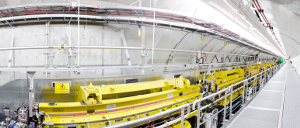 |
 |
|||||||||||||
|
|||||||||||||
|
|||||||||||||
|
More than 1034 times per second per square centimetre — thatís how often electrons and positrons are supposed to collide in the ILC. The projectís accelerator experts have no doubts that it can be done, but they have to demonstrate it, too. An important proof is to run ILC-like beam conditions through a radiofrequency (RF) unit that consists of one klystron and 26 superconducting cavities housed in three cryomodules. Running ILC-like beam conditions means running the cavities at their gradient limits and with 800-microsecond beam pulses with an average current of about nine milliamperes (or mA). The FLASH accelerator at DESY is capable of approaching these ILC-like beam conditions, but they are at the design limits of the machine and are well beyond typical operating conditions. An international team with members from DESY, FNAL, SLAC, KEK, and Argonne have come together for a series of tests that wants to drive an ILC-like beam through FLASH.
The primary challenge is to create, accelerate and stabilise the required long train of high-charge bunches. A particular problem are the resulting high average beam powers, which must be transported loss-free to the main FLASH beam dumps. Identifying any problems now would greatly benefit both the European XFEL and the ILC because all three machines (including FLASH itself) use the same acceleration technology, just with different parameters. In a series of tests during May and September, the international team started testing subsystems and generally preparing FLASH for the high-power beam, and while increasing the bunch count the team did run into some difficulties that they hope to solve before the big run planned for spring next year. Back in May, things had become difficult at anything more than 15 bunches because of excessive beam loss, so the first challenge the team had to overcome in September was to understand how to tune the accelerator to be able to better transport the high-charge three-nanocoulomb bunches. This time the team was successful, and they were then able to continue pushing the machine, first ramping up the beam pulses from 30 microseconds to more than 500 microseconds with a beam current of 1 milliampere (a factor of three short of the final goal). “We managed to get the high-power beam through the bypass and obtained a very good set of data that we are now looking at,” says DESY's Nick Walker. When ramping up to 550 microseconds, however, the beam 'tripped' the vacuum some 70 centimetres in front of the main beam dump at a flange connection to a beam position monitor, causing a vacuum leak and putting an untimely end to the studies. “We actually have a complete spare tube sitting ready, but unfortunately the leak happened within a wall of concrete shielding that we can't easily access,” explains Nick Walker. “Before we can run these high-power beams again, we have to improve the machine protection.” A copper window was installed as a temporary solution to separate the faulty vacuum around the dump from the machine vacuum, allowing FLASH to run at its typical low-power parameters for its photon users. Plans for a full repair are currently being discussed. Once the dump vacuum is repaired, the team hopes to be able to perform the full current demonstration sometime in 2009. -- Barbara Warmbein |
|||||||||||||
| © International Linear Collider |

